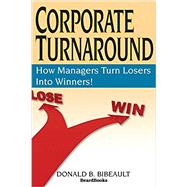|
xiii | ||||
| Preface | xv | ||||
| Acknowledgments | xvii | ||||
| About the Author | xix | ||||
| Introduction | 1 | (6) | |||
| PART ONE: THE REASONS FOR CORPORATE DECLINE | |||||
|
7 | (10) | |||
|
7 | (1) | |||
|
8 | (2) | |||
|
10 | (1) | |||
|
11 | (6) | |||
|
17 | (6) | |||
|
17 | (1) | |||
|
18 | (5) | |||
|
23 | (4) | |||
|
27 | (8) | |||
|
27 | (1) | |||
|
28 | (1) | |||
|
29 | (1) | |||
|
30 | (1) | |||
|
31 | (1) | |||
|
32 | (3) | |||
|
35 | (14) | |||
|
35 | (3) | |||
|
38 | (2) | |||
|
40 | (1) | |||
|
41 | (1) | |||
|
42 | (1) | |||
|
43 | (1) | |||
|
43 | (1) | |||
|
44 | (5) | |||
|
49 | (12) | |||
|
49 | (1) | |||
|
50 | (3) | |||
|
53 | (5) | |||
|
58 | (3) | |||
|
61 | (12) | |||
|
61 | (1) | |||
|
62 | (1) | |||
|
62 | (4) | |||
|
66 | (2) | |||
|
68 | (5) | |||
|
73 | (8) | |||
|
74 | (1) | |||
|
75 | (1) | |||
|
76 | (5) | |||
| PART TWO: THE BASICS OF CORPORATE TURNAROUND MANAGEMENT | |||||
|
81 | (10) | |||
|
81 | (1) | |||
|
82 | (4) | |||
|
86 | (1) | |||
|
87 | (1) | |||
|
88 | (1) | |||
|
89 | (1) | |||
|
89 | (2) | |||
|
91 | (20) | |||
|
92 | (1) | |||
|
93 | (2) | |||
|
95 | (4) | |||
|
99 | (3) | |||
|
102 | (4) | |||
|
106 | (1) | |||
|
107 | (4) | |||
|
111 | (14) | |||
|
111 | (2) | |||
|
113 | (2) | |||
|
115 | (3) | |||
|
118 | (3) | |||
|
121 | (4) | |||
|
125 | (16) | |||
|
125 | (2) | |||
|
127 | (2) | |||
|
129 | (1) | |||
|
130 | (1) | |||
|
131 | (1) | |||
|
132 | (2) | |||
|
134 | (7) | |||
| PART THREE: LEADERSHIP IN TURNAROUND SITUATIONS | |||||
|
141 | (8) | |||
|
141 | (4) | |||
|
145 | (4) | |||
|
149 | (14) | |||
|
149 | (2) | |||
|
151 | (2) | |||
|
153 | (3) | |||
|
156 | (2) | |||
|
158 | (5) | |||
|
163 | (18) | |||
|
163 | (3) | |||
|
166 | (3) | |||
|
169 | (3) | |||
|
172 | (4) | |||
|
176 | (1) | |||
|
177 | (4) | |||
|
181 | (22) | |||
|
181 | (1) | |||
|
182 | (4) | |||
|
186 | (3) | |||
|
189 | (2) | |||
|
191 | (2) | |||
|
193 | (4) | |||
|
197 | (6) | |||
| PART FOUR: MANAGEMENT STRATEGIES AND PRACTICES IN A TURNAROUND | |||||
|
203 | (28) | |||
|
203 | (2) | |||
|
205 | (4) | |||
|
209 | (4) | |||
|
213 | (6) | |||
|
219 | (4) | |||
|
223 | (2) | |||
|
225 | (6) | |||
|
231 | (32) | |||
|
231 | (3) | |||
|
234 | (3) | |||
|
237 | (2) | |||
|
239 | (12) | |||
|
251 | (4) | |||
|
255 | (8) | |||
|
263 | (36) | |||
|
263 | (1) | |||
|
264 | (4) | |||
|
268 | (9) | |||
|
277 | (7) | |||
|
284 | (9) | |||
|
293 | (6) | |||
|
299 | (38) | |||
|
299 | (1) | |||
|
300 | (2) | |||
|
302 | (9) | |||
|
311 | (7) | |||
|
318 | (8) | |||
|
326 | (7) | |||
|
333 | (4) | |||
|
337 | (26) | |||
|
337 | (1) | |||
|
338 | (2) | |||
|
340 | (6) | |||
|
346 | (4) | |||
|
350 | (7) | |||
|
357 | (6) | |||
| Appendix | 363 | (10) | |||
| Selected Bibliography | 373 | (22) | |||
| Index | 395 |









